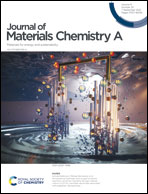Discharge voltage profile changes via physicochemical phenomena in cycled all-solid-state cells based on Li10GeP2S12 and LiNbO3-coated LiCoO2†
Abstract
In the field of all-solid-state Li-ion batteries, understanding and controlling contact loss and interfacial reactions in composite electrodes over long-term cycling remains challenging. This study investigated how various physicochemical phenomena individually affect the discharge profile upon cycling for a solid-state cell with the following composition: LiNbO3-coated LiCoO2 + Li10GeP2S12|Li10GeP2S12|In–Li alloy. Two specially designed cells were prepared to separately characterise contact loss or interfacial chemical reactions, by means of electrochemical measurements and chemical analysis. It was found that in the discharge process, contact loss induced a certain overpotential compared to the initial value, while the chemical reaction accounted for the capacity loss caused by an additionally increased overpotential in the final stage of the discharge process. The overpotential from the undesired chemical reaction was proposed to be due to the high Li-ion transfer/migration resistance induced by sulphate formation and the decrease in the lithium content at the LiNbO3/Li10GeP2S12 interface.



 Please wait while we load your content...
Please wait while we load your content...